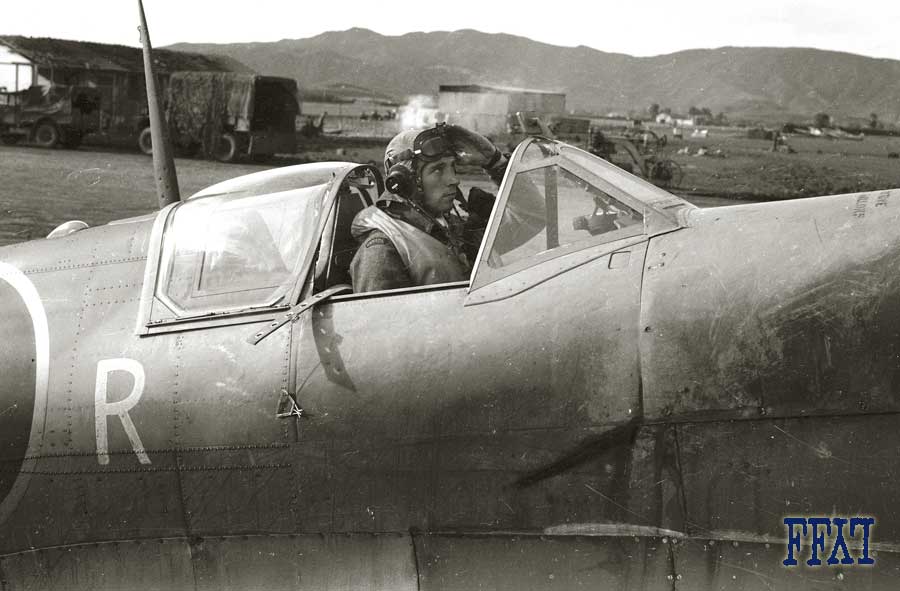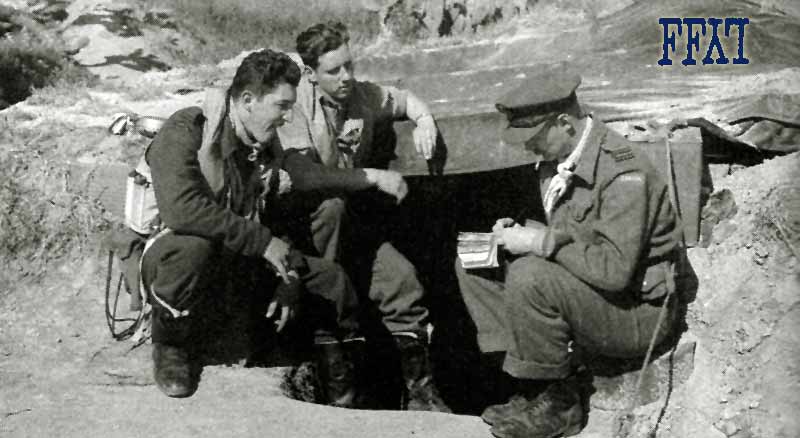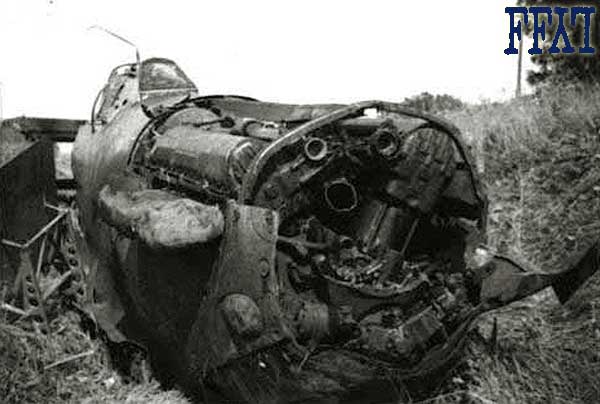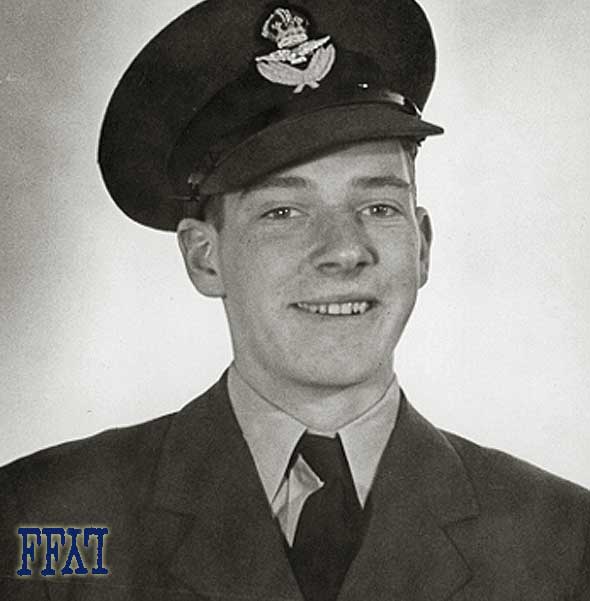|
--------------------------------------------------
 P/O C. E. Peppler, 116 Gerrard Street, Winnipeg, is a Spitfire pilot with an RAF sqn. in N. Africa
P/O C. E. Peppler, 116 Gerrard Street, Winnipeg, is a Spitfire pilot with an RAF sqn. in N. Africa Oranges, Arabs And Mud Say Canadians of Africa
(By F/L JOHN CLARE, R.C.A.F. Public Relations Officer in North Africa.) - North Africa, Feb. 16, 1943 — North Africa is a long way from Portage and Main in more ways than one, but there is a frosty nip in the air these days that provides a link with the land that Canadians left behind them. It is far closer to a crisp autumn morning in Canada than to the popular conception of sand dunes, bobbing camels and date palms.
If you asked the average Canadian fighter pilot to tell you in three words his impression of the country in which this campaign is being fought it is quite likely he would say “oranges, Arabs and mud.” The mud is probably the stickiest and muddiest that any fighting man ever plowed through.
Life up forward is rough, but many of the edges are taken off by the ingenuity and resourcefulness of the pilots. Canadian boys are particularly adaptable. Makeshift furniture and other comforts appear quickly and with apparent ease when you get a squadron of resourceful young men working on ways and means to make life more pleasant.
The Gasoline Tin
In these efforts to reduce the discomforts of life at a forward air field the ubiquitous gasoline tin figures large. There was one squadron sent forward swiftly in the early days of the campaign whose equipment, apart from their aircraft, was a collection of empty gasoline tins and a field telephone. They placed the telephone on one tin and ranged the others about in a circle and that was their flight shack, their orderly room and their mess.
Food and shelter for the night was arranged as soon as they arrived, but the gas tins provided them with their operational headquarters. These tins, after discharging their original duty, reappear in strange forms. They become washstands, stoves, lamp shades and cooking utensils.
Another phase of front line life in which Canadians have displayed considerable natural ability is scrounging. Scrounging is the process of getting something, for nothing if possible, that theoretically does not exist in the country. Good scroungers take pride in their work and their principles are well defined and stern. They shrink from paying as much as they abhor borrowing or stealing, if you want to be moral about it.
One of the most accomplished scroungers in North Africa is a Toronto flying officer. By his eloquence and modest bearing he claims to have reduced a hard- boiled English sergeant-major almost to tears as he told the story of his plight. He left the supply depot well stocked with good things in bottles and cans. His operations have netted him in part, one motorcycle, as well as many eggs and other delicacies. His fame has reached the point where members of the squadron place orders with him and he goes out on mysterious missions which invariably produce the needed articles.
As in England, most of the squadrons have adopted mascots and pets, in most cases friendly Arab dogs whose allegiance to their new masters rests on a sound foundation of ration biscuits and scraps from mess tins.
North African Hotel
High in the mountains and far behind the most forward air fields of the R.A.F. in this campaign there is a hotel where a cavernous fireplace, well stocked with crackling logs and a larder that includes eggs, provides the sort of atmosphere that makes fliers forget the war.
It is a place where fliers, who have been slugging it out with the enemy air force over Tunisia, can come for their 48-hour leaves and get relaxation, good food and companionship in large quantities. Here there are none of the amenities found in Britain, so this hotel has been chosen as a place for weary pilots to go and sleep until noon and eat meals that don’t come out of cans and do not include ration biscuits.
Up at the front it is a somewhat different picture—the front being to fliers the forward air fields from which they carry the war in the air to the enemy. It’s tough up there. The fliers, who include many Canadians, most of them fighter pilots of experience in the air war in Europe, are getting the best there is. The food is excellent, even though it does come from tins. Sleeping accommodation is often a tent. There are some units that have been fortunate enough to secure substantial farm houses. Of food and clothing and field equipment there is an abundance, despite the difficulties of transport and communication.
Their health is excellent except perhaps in cases where the glow of oranges fresh from the trees was a little too dazzling and the boys found themselves eating too much of the fresh fruit.
Couldn’t Be Higher
Morale, whatever that is, seems to be high. If broad Canadian grins and the kind of good-natured horseplay that indicates good spirits is any indication, morale couldn’t be higher.
The Canadian fliers and their comrades from all parts of the Empire in these R.A.F. squadrons are getting plenty of action. The same fellows who sat around dispersal huts in Great Britain and complained about the inaction and looked longingly at the draft to the east are happy now. They are getting a crack at Jerry and it seems that that is what a fighter pilot wants more than anything else in this war.
They are having some difficulty and a great deal of amusement with their French. The Arabs —pronounced Ae-rabs out here— are now accepted as part of the new and strange landscape and panorama. Fezzes and donkeys are accepted now as the backdrop against which they are living and fighting in this new theatre of war.
Mail, always of the greatest importance to young men at war, takes on an even greater meaning and importance out here, where it is less frequent than it was in Great Britain. They all say they would like more magazines and newspapers.
They are facing the enemy with respect and without fear; they are getting on with the job and everywhere they go they are entering into squadron life with its responsibilities and pleasures in the same enthusiastic way which has won them a reputation and a tradition in this war, as it did in the last.
--------------------------------------------------
Born 30 November 1918 in Winnipeg, Manitoba.
Home in Winnipeg.
Enlisted in the Army, July 18,1940.
Later joining the RCAF, May 28,1941.
Trained at
No 1 Manning Pool, Toronto, Ont (May 28, 1941).
No 1 I.T.S. Toronto, Ontario (Aug 9, 1941).
No 10 E.F.T.S. Mount Hope, Ontario (Sept 13, 1941, Fleet Finch).
No 6. S.F.T.S. Dunnville, Ontario (Nov 12, 1941, First logged flight Yale).
Winged 27 Feb. 1942 & promoted to P/O #251942.
No. 9 A.F.V. Hullavington,Wiltshire, England (May 7, 1942 Master I)
OFT at No. 58 O.T.U. Grangemouth
(May 29 - Master III, June 3 - Spitfire I, June 11 - Swordfish).
Advanced OFT at No. 58 O.T.U. Balado Bridge, Scotland.
Posted to 421 Squadron 23 Aug. 1942, Fairwood Common, South Wales.
Attached to No 1528 B.A.T. Flight - West Malling, Kent
(Sept. 14 - 19 for a course on flying blind approach landings).
Back to 421 Sqn. Fairwood Common, South Wales.
Promoted to F/O 1 October 1942.
Temporary Duty to Kenley, Surrey, England, 7-9 Oct. 1942.
Moved 421 Sqn. to Angle, South Wales, 19 Oct. 1942.
Attached to 43 Sqn RAF, Maison Blanche, Algiers, 29 Nov. 1942.
Posted to 81 Sqn RAF, Algiers/Mason Blanche, 30 Nov 1942.
North Front - Gibraltar (17 Jan 1943).
Tingley - Constantine (31 Jan - 30 Mar) Tripoli, Egypt, Tunisia.
Souk-el-Khemis, "Paddington" Tunisia - N. Africa (1 April - 12 May '43).
Posted as F/C "B" Flight, 232 Squadron, Ta Kali, Malta, 6 July (effective 6 Dec.).
322 Wing, 112 Group R.A.F. M.E.F, Ta Kali, Malta (12-22 July, 1943).
232 Sqn. R.A.F. Lentine, Sicily, Catania Valley (23 July - 30 Aug).
Lentine to Agnone 'dromes, Italy (Aug 31).
Sqn moved to Milazzo East Airdrome (6-16 Sept).
Sqn moved to Asa landing ground, Salerno, Italy (16-24 Sept).
Sqn moved to Serretelle Meadows, Salerno Area, Italy (24 Sept - 15 Nov).
Posted to A.F.V. - R.A.F. Setif, N. Africa on instructional duties to do a rest period.
Hospitalized with hepatitis/yellow jaundice/malaria from water source, 15 Nov '43.
A.F.T. R.A.F. Taher - North Africa (31 Dec 1943 - 28 Mar 1944).
Posted to H.Q.D.A.F. but proceeded to 322 wing in Corsica instead
(via Algiers, Sardinia & Corsica).
Supernumerary to 322 Sqn. Pro Tem. (7 May 1944).
Posted to 242 Sqn. as F/Commander "B" Flight (9-20 May 1944).
Shot down over Italy May 20th 1944 while on a weather recce.
Crash-landed his Spitfire IX near Cecina in enemy occupied territory.
H
e was captured and then hospitalized with a head injury.
He was later transferred to a POW camp STALAG Luft III.
Word sent July 13th 1944.
Sadly, Calvin passed away at his home on Sunday July 19th 2015 at 7:29 holding
his wife Audrey's hand. They had been married 62½ years. |
--------------------------------------------------

Paddington, April 1943 - Olmsted & Calvin Peppler talk to Canadian PR man, F/L Les Powell
Local Flyer, Bill Olmsted, One of The Canadians Who Are Doing a Good job in Tunisia
Increasing Number From Canada Seeing Action on Desert Front
(By Ross Munro, Canadian Press War Correspondent)
With the RAF in North Africa, 25 Feb. 1943 – (CP Cable) – An increasing number of Canadian fighter pilots are in action on the Tunisian front and S/L Jimmy Walker of Edmonton, now commands a Spitfire squadron, the first Canadian-led RAF squadron in North Africa.
Walker has just been awarded a bar to his Distinguished Flying Cross. His citation reads: “This officer has destroyed four enemy aircraft and damaged four others since his arrival in North Africa. His untiring efforts and leadership merit the highest praise. His example has been an inspiration to other pilots in his wing and has contributed greatly to the wing success in the air.”
Flying with Walker at different times during the campaign have been several other Canadians who have been knocking off enemy aircraft.
Toronto Man Promoted
Alan Aikman, of Toronto, has been promoted from the rank of F/O to that of F/L and he now is leading a flight of Spitfires. Aikman flew No. 2 to the famous Irishman, Paddy Finucane, and was with him the day he was shot down off the French coast by anti-aircraft fire. The Torontonian has a score of five enemy planes destroyed in North Africa. Recently he shot down a Focke-Wulf 190 in an air fight over the Mediterranean. The German plane crashed on the shore.
Aikman said Spitfires have been doing a large number of sweeps recently to harry the Germans on the northern sector of the front. "The Jerries don't seem to want to mix it up with us," he said, "Sometimes we get a dozen or 15 in the sky but they sheer off when we get in at them. So life is a little dull at times these days."
Another high-scoring Canadian is P/O Harry (Junior) Fenwick, of Leamington, Ont., who has destroyed five of the enemy and damaged five more, besides having a probable to his credit. He wears the ribbon of the Distinguished Flying Cross.
Flying in the same squadron as Fenwick are six other Canadians: Sgt. Louis Hamilin, Sgt. Donald Rathwell, and P/O Calvin (Pep) Peppler, all of Winnipeg; F/Sgt. Douglas Husband, of Toronto; F/O Bill Olmsted, of Hamilton, Ont., and Sgt. John Olsen, of Kirkland Lake, Ont.
With another squadron that flies on sweeps with Fenwick and his crowd are P/O Jim Woodill, of Halifax, F/L Glen Lynes, of Montreal, who has just been promoted from the rank of P/O and leading a flight like Aikman, P/O C. F. Sorensen, a Dane from Kingston, and P/O Howard McMinniman, of Fredericton.
Flying with still another R.A.F. squadron that included a half-dozen Canadians is F/O R. W. Robertson, of Sydney, N.S., who has been through a couple of recent scraps over Tunisia. On a dawn patrol he ran into seven Nazi fighters and engaged them immediately. He took on three at first and headed straight at them. At less than 100 yards, he squirted lead at one and saw it break away and dive for the ground, riddled with bullets. Troops on the ground saw it crash and Robertson got the credit for destroying it.
He was not finished, though. He chased after the rest and damaged two before returning to his base in time for breakfast. Robertson flies a Spitfire with the name Bluenose painted on its nose. He has done almost 150 operational hours as a fighter pilot.
A great friend of a large number of Canadian pilots out here is F/Sgt. Tony Jonsson, the only Icelander in the R.A.F., who was recently awarded the Distinguished Flying Medal. His score is three destroyed, one probable and one damaged.
--------------------------------------------------
Air Force Casualties
30 June 1944 – The Department of National Defense for the Air Force today issued casualty list No. 922 of the Royal Canadian Air Force. This list includes:
Overseas – Missing on Active Service on Air Operations:
Peppler, Calvin Edward, F/L, Winnipeg

The wreckage of his Spit, brought down by Flak over Italy
--------------------------------------------------
Air Force Casualties
23 July 1944 – The Department of National Defense for the Air Force today issued casualty list No. 942 of the Royal Canadian Air Force. This list includes:
Overseas – Reported Prisoner of War (Germany):
Peppler, Calvin Edward, F/L, Winnipeg
--------------------------------------------------
Dear Folks,
I trust that you have long ago received word as to my safety and therefore not worried too much. This is the third letter, so you should have the details I can give. Just in case they did not arrive, I am now in my camp resting in hospital. I am not very sick but concussion left me with headaches and weak from loss of blood.
Soon I will be O.K. and can return to exercise and studies with the rest of the camp. I cannot write very much so do not worry because the mail is slow. You may give my address around and I'll take turns in my answers. Do not worry about sending things for one food parcel is the limit and I say the Red Cross (P.O.W.) do wonders for us.
Love to all,
Calvin
--------------------------------------------------

--------------------------------------------------
No Known Victories
|







